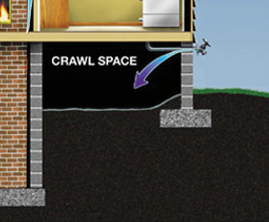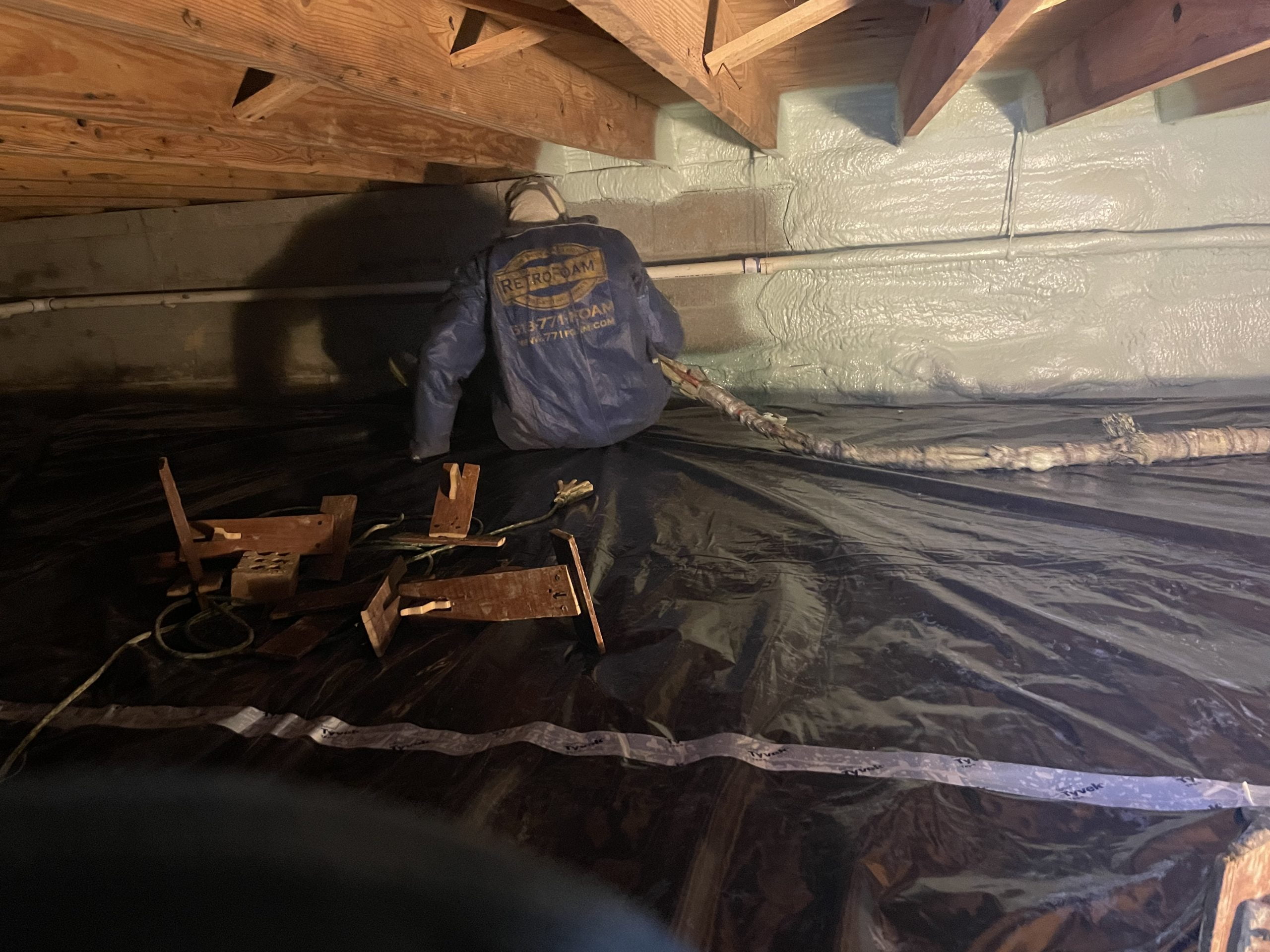The evolution of insulation materials has significantly advanced over the years, introducing convenient and efficient solutions like spray foam insulation for notoriously hard-to-insulate areas like crawl spaces, attics, and basements. The question of how exactly this remarkable process works, its benefits, and why it’s specifically effective for crawl spaces are some of the puzzles that this article aims to solve. Additionally, we will jump into comparative cost analyses, real-life examples, and common queries about spray foam insulation.
Understanding Crawl Spaces and Their Challenges
The crawl space refers to an unfinished, low-ceilinged area beneath the first floor of a building. It provides easy access to the wiring, plumbing, and other utilities that run underneath the structure. Despite its usefulness, the crawl space, especially the vented crawl space, can introduce a host of challenges to your existing home.
Definition and Role of Crawl Spaces
A crawl space is a type of foundation with an accessible under-floor area that is not habitable. The crawl space allows cool air to circulate, promotes airflow, and helps keep the floor joists from rotting by providing a space for moisture to go. Notably, it provides easy access to install and inspect utilities.
Common Problems in Crawl Spaces
Unfortunately, crawl spaces can come with a few challenges. These consist of moisture buildup, insulation issues, foul odors, and pest invasion. Moisture builds due to lack of proper insulation and can lead to mold growth, causing poor indoor air quality. Additionally, the dirt and moisture in unheated crawl spaces can attract pests, leading to possible infestations.
Introduction to Spray Foam Insulation
Spray foam insulation is an alternative to traditional building insulation such as fiberglass batts insulation and foam board. Instead of trapping moisture like fiberglass or batt insulation, spray foam is air-sealing and moisture-resistant. It can be used to insulate everything from your roof to floor joists and is considered one of the best insulation methods.
How Spray Foam Insulation Works
Spray foam insulation works by expanding into a solid mass upon application. This makes it fantastic for insulating hard-to-reach spaces as the spray foam is applied using a spray foam gun.
Benefits of Using Spray Foam Insulation
Due to its expansive nature, spray foam insulation provides an airtight seal that reduces heat transfer, significantly improving your home’s energy efficiency. This in turn leads to lower energy bills and helps maintain a consistent temperature in your home.
Reasons to Use Spray Foam Insulation in Crawl Spaces
Spray foam crawl space insulation is increasingly becoming popular due to its superior insulating qualities and extreme versatility. Here are some reasons why homeowners should consider spray foam for insulating crawl space insulation.
Improved Energy Efficiency
Spray foam insulation improves energy efficiency by creating a barrier that reduces heat transfer between the crawl space and your living space. This helps to reduce energy bills by keeping your home warmer in winter and cooler in summer. In other words, your heating bill will be lower, and your house will feel more comfortable all year round.
Mold and Moisture Control
Spray foam insulation creates an effective moisture barrier, which is particularly important in the damp environment of a crawl space. A moisture-free crawl space will undoubtedly contribute to better air quality within your home. The closed-cell spray foam insulation performs well in controlling moisture, preventing condensation and resultant mold growth.
Pest Control
When applied, closed-cell spray foam expands and sets hard, making it an effective barrier against pests. Rodents and bugs can’t chew through it, which reduces the risk of infestations. This enhances indoor air quality as it eliminates the nasty smells that come with pest problems.
Installation of Spray Foam Insulation in Crawl Spaces
To maintain consistent temperature in an existing home, spray foam crawl space insulation is an excellent option. This foam insulation is ideal for the underside of your house, specifically in crawl spaces, walls, and floor joists. As opposed to fiberglass insulation, spray foam creates a moisture barrier, helping prevent the growth of mildew and mold.
Vented crawl spaces can be a hotbed for moisture build-up and can invite cold air into your living space, raising your energy bills. Spray foam insulation combats these issues effectively by sealing off open points and reducing heat transfer.
DIY vs Professional Installation
There are both DIY spray foam insulation kits and professional services available. Using spray foam guns and foam boards can be a cost-effective and hands-on approach. However, it requires carefulness to avoid mistakes like trapping moisture or under-insulating, which can lead to high energy bills in the long run.
However, fiberglass batt insulation or batt insulation is harder to install than spray foam. Professionals can provide a sealed and secured installation, maintaining indoor air quality, especially in crawl space insulation, using closed-cell spray foam.
Step-by-Step Process of Installing Spray Foam Insulation
Here is a simple 5-step DIY guide to installing spray foam crawl space insulation:
1. Clear and clean the crawl space from any debris or existing insulation.
2. Make sure the area is dry to avoid moisture trap.
3. Apply a vapor barrier to the ground and walls of the crawl space.
4. Apply the spray foam using a spray gun to the walls and rim joists.
5. Inspect for any spots missed and apply foam as necessary.
Cost-Benefit Analysis of Spray Foam Insulation in Crawl Spaces
Initial Cost of Spray Foam Insulation
The initial insulation cost for spray foam can be higher than methods like fiberglass and foam board. However, it’s crucial to consider the quality, damage resistance, and longevity of spray foam insulation.
Long-Term Savings and ROI
A significant advantage of spray foam insulation is its energy efficiency. It helps maintain a consistent temperature in the living space, thereby reducing heating bills. Given the energy savings, the ROI for spray foam insulation can be realized within a few years.
Safety Concerns with Spray Foam Insulation
Homeowners are often concerned about the potential safety implications of installing spray foam insulation. If not correctly installed, materials like a vapor barrier can indeed trap moisture against wood and encourage mold growth which can significantly affect indoor air quality and ultimately pose health hazards.
That’s where a professional with a precise spray foam gun comes in. With the right application, spray foam does not encourage moisture build-up and it does not degrade indoor air quality. In fact, the consistent temperature maintained by spray foam insulation can help improve overall air quality by keeping humidity steady.
Maintenance and Longevity of Spray Foam Insulation
Spray foam insulation has a fantastic lifespan. Unlike fiberglass batt insulation or foam board which can sag and slide over time, foam insulation remains fixed in place. As it doesn’t collect dust or mold in the same way as traditional insulation materials might, it requires very little maintenance other than occasional inspection for any cracks or damage that may occur. Some studies have shown that spray foam does not degrade or lose significant insulating ability if undisturbed. With proper installation and protection, spray foam insulation is a set-it-and-forget-it method of insulating that provides excellent longevity and performance.
Spray foam insulation is known for being very durable and long-lasting when properly installed. One of the great benefits of spray foam is that it adheres tightly to surfaces, sealing cracks and gaps. This prevents air leaks which can reduce a building’s energy efficiency over time. Once cured, the closed cell structure of spray foam resists moisture and improves the building envelope’s ability to prevent water intrusion. Provided it is not exposed to direct sunlight, properly installed spray foam can last for decades.
Conclusion: Why Spray Foam Insulation Is The Ultimate Solution
As concluded above, spray foam insulation offers numerous benefits over traditional fiberglass batts, cellulose, or loose-fill insulation. In comparison to these insulation methods, spray foam provides a higher R-value, meaning it’s more resistant to heat flow and, therefore, more efficient in insulating your home against cold air. This can result in significant energy savings over time, providing homeowners satisfaction while enabling a significant decrease in high energy bills.
Recap of Advantages of Spray Foam Insulation
Foam insulation creates an ideal barrier against cold air, maintains consistent temperatures, improves indoor air quality, reduces the potential for moisture buildup, and plays a major role in energy efficiency. Its durability and long lifespan also make it an ideal component for a home insulation system.
Future Trends in Insulation for Crawl Spaces
Improvements in technology and a rising interest in energy efficiency are driving new developments in the insulation realm, especially in spaces, such as vented crawl spaces and basements, that have been consistently difficult to insulate effectively.
Newer spray foams like closed cell spray foam insulation are becoming more popular for crawl spaces. Closed-cell foam provides a higher R-value than its open-cell counterpart and also acts as a moisture barrier, eliminating the need for a separate barrier in damp areas like crawl spaces.
Let’s Review
In summary, spray foam insulation offers unparalleled benefits for insulating crawl spaces compared to traditional insulation methods. Its ability to air seal, insulate, and control moisture and condensation makes it the ideal solution for this unique area of a home. By preventing outside air infiltration, blocking moisture, inhibiting mold growth, and maximizing energy efficiency, spray foam allows crawl spaces to be converted into usable space. Though initially more expensive than other types of insulation, it offers the highest long-term return on investment through energy savings and improved air quality. For these reasons, spray foam insulation provides comprehensive protection and is the ultimate solution for insulating crawl spaces in any climate.
Cincinnati RetroFoam Can Help!
Cincinnati RetroFoam offers exclusive spray foam insulation services for your home’s crawl space. Our specially formulated foam helps control moisture, pests, and air leaks, creating a more comfortable home. Call Cincinnati RetroFoam today to learn how we can customize our services for your crawl space needs.
Frequently Asked Questions About Spray Foam Insulation
Does crawl space foam need vapor barriers?
Crawl space foam insulation often does need a vapor barrier as it allows water vapor to pass through, which can then condense and cause mold, rot, or other problems. The foam itself is not usually a vapor barrier, so additional plastic sheeting or other material is installed to prevent moisture from accumulating in the foam or crawl space. Proper vapor barriers are important for crawl space insulation to work effectively.
What thickness of foam is recommended?
The recommended thickness for crawl space foam insulation is generally 1-2 inches. Going with 1.5-2 inches provides good insulation and energy efficiency. Too thin of foam may not insulate well, while too thick is unnecessary and more expensive. The exact thickness depends on the climate zone and goals for insulation R-value.


